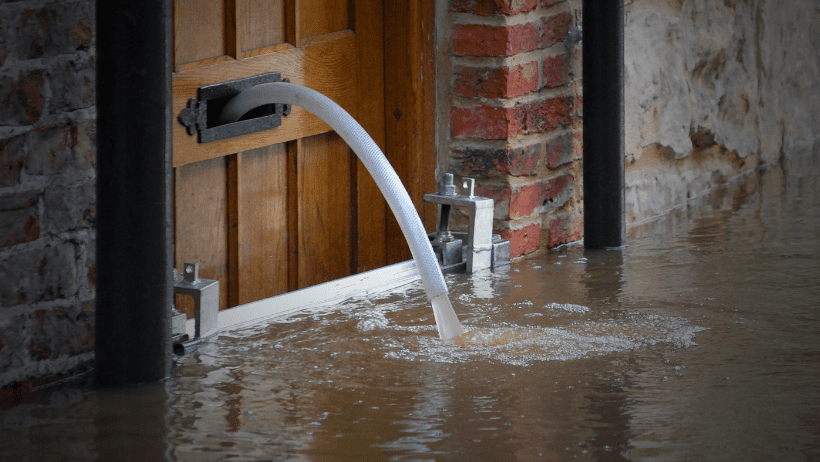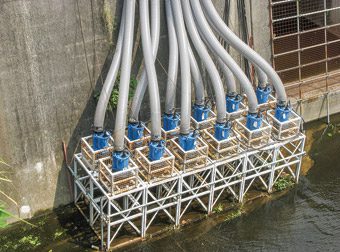A submersible pump excels at more than just clearing water from pools; it’s an essential asset in flood management. These pumps offer a proactive approach to flood prevention, especially crucial for those in areas prone to such disasters.
They help mitigate the impact of floods by controlling water levels in underground spaces like basements, thereby safeguarding properties and easing the burden of securing flood-related insurance.

Types of Submersible Pumps for Flooding
Automatic vs. Manual Pumps
Submersible pumps for flooding come in manual and automatic types with various capacities suited to different scenarios. The appropriate capacity depends on the volume of water to be moved and its elevation to a drain.
While bigger pumps aren’t always better, consulting an expert at Tsurumi Pump can help determine the right size. Automatic pumps feature a float switch activating the pump when water reaches a set level.
Portable versions are also available for emergency use, like draining flooded areas, swimming pools, or water tanks, helping to prevent flood damage.
Pumps for Dirty Water
Submersible pumps designed for dirty water excel in flood conditions where water contains debris. Engineered to handle solids, they prevent clogs and surpass clean water pumps in tough environments.
Robust construction ensures continuous operation, reducing damage and speeding up recovery during severe floods. Their durability and reliability offer reassurance and consistent performance in challenging conditions.
Benefits of Using Submersible Pumps in Flood-Prone Areas
 #1 Prevention of Property Damage
#1 Prevention of Property Damage
Submersible pumps are indispensable in flood-prone areas, playing a critical role in preventing property damage. By swiftly removing excess water, these pumps mitigate the risk of structural harm to homes, buildings, construction sites, and maintain property integrity.
This proactive measure keeps buildings safer and drier, preserving their value and guarding against long-term issues like water ingress.
#2 Cost-Effectiveness
The financial logic behind installing submersible pumps is clear when considering the high costs associated with flood damages.
As a preventative investment, these pumps significantly curtail potential repair expenses by protecting properties from the devastating effects of water damage, yielding substantial long-term savings.
#3 Rapid Water Removal
Designed for efficiency, submersible pumps excel at removing water quickly, crucial for minimising damage to buildings and infrastructure.
Speedy water removal reduces structural instability risks and lowers the likelihood of health hazards such as mould and pests, enhancing safety in the immediate aftermath of a flood.
#4 Reduce Disruption
High-capacity submersible pumps play a vital role in minimising disruptions in flooded areas, quickly clearing water from roads and public spaces. This accelerates the restoration of normal activities, helping communities recover sooner.
#5 Environmental and Safety Considerations
Utilising dewatering pumps responsibly involves selecting energy-efficient models and minimising ecological impact. These pumps facilitate the safe management of floodwaters, reducing the risk of electrical hazards and structural collapses, and preventing water contamination.
#6 Efficient Water Management and Quick Recovery
Submersible pumps control water flow effectively during and after floods, aiding in quick recovery efforts. By efficiently managing water resources, these pumps help communities rebuild faster and prepare better for future flooding events.
Setting Up a Submersible Pump for Flood Prevention
 Selecting the Right Location
Selecting the Right Location
Setting up a submersible pump correctly is crucial for effective flood prevention. Here are key considerations for selecting the right location:
- Strategic Placement: Identify areas most likely to accumulate water, such as cellars and basements.
- Accessibility: Ensure the pump is accessible for maintenance and not obstructed by various items.
- Proximity to a Power Source: Place the pump near a reliable power source for continuous operation.
- Elevation: Consider elevating the pump slightly off the ground to avoid sucking up sediment.
Installation Process for Submersible Pumps: Step-by-Step
- Site Assessment: Inspect the installation site for water accumulation and identify the optimal placement for the pump.
- Preparation: Clear debris from the area and ensure a stable, flat surface for pump placement.
- Pump Placement: Position the pump in the designated spot, ideally at the lowest point to maximise water extraction.
- Electrical Connection: Connect the pump to a suitable power source, adhering to all electrical safety standards.
- Pipe Installation: Attach the discharge pipe securely, ensuring it leads away from the property to an appropriate drainage area.
- Testing: Test the pump by briefly running it to ensure it operates correctly and efficiently removes water.
- Maintenance Check: Regularly inspect the pump and surrounding area to maintain optimal performance and prevent blockages.
Choosing the Right Submersible Pump
Factors to Consider
When choosing the right submersible pump, several detailed factors should be carefully evaluated to ensure optimal performance and longevity:
- Power and Efficiency: The power of the pump should align with your needs, either single or three phase. Evaluate energy efficiency as well, especially for frequent or long-duration use.
- Capacity and Flow Rate: Consider the pump’s capacity, often indicated as cubic meters per minute (CPM). For larger or more demanding flood scenarios, a higher CPM may be necessary to prevent water accumulation effectively.
- Material Durability: The construction material of the pump impacts its resistance to wear and tear. Stainless steel and cast iron materials are common, offering different levels of durability against corrosion and abrasion. Stainless steel is preferable for corrosive liquids, as it withstands harsher environments.
- Submersible Pump Types: Depending on the application, you might choose between automatic and manual pumps, or between those designed specifically for clean water versus dirty water. Each type has specific features tailored to different operational conditions.
Conclusion: Enhancing Flood Response with Submersible Pumps
Submersible pumps are crucial in managing and mitigating floods efficiently. Their robust construction allows for rapid deployment and operation in flood conditions.
These pumps are invaluable for reducing flood impacts and aiding in the swift restoration of affected areas.
Looking for a dependable flood management solution? Explore our Tsurumi Pumps collection, designed for powerful and effective flood response. Contact us for more information or to get a free sales quote, and ensure you’re prepared with high-quality dewatering pumps.

 #1 Prevention of Property Damage
#1 Prevention of Property Damage Selecting the Right Location
Selecting the Right Location